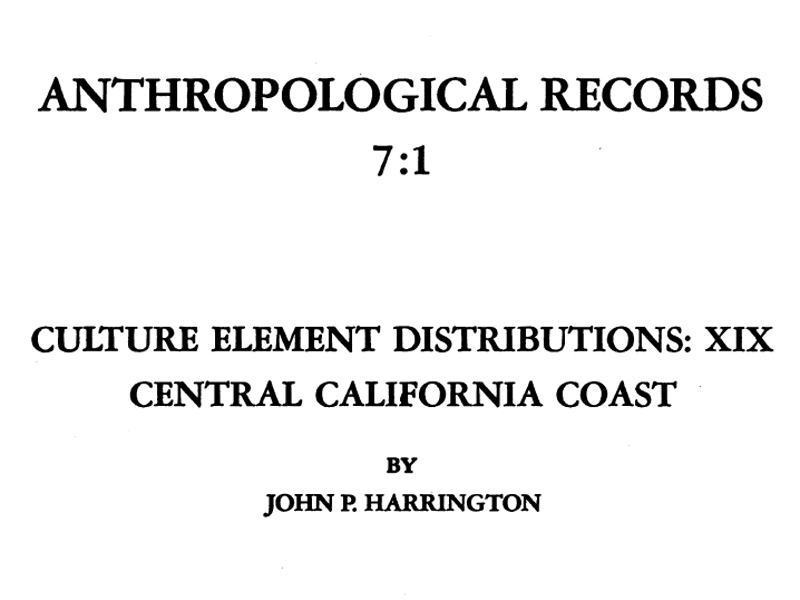|
|

Local Ethnobotany: TEA21 Rural Roadside Inventory.
Native American Consultation and Ethnographic Study
Caltrans District 7, County of Los Angeles.
Department of Anthropology, University of California San Diego, La Jolla, CA 92093-0532
For: Jones & Stokes/IFC International
December 2008
|
Abstract.
The objective of this survey has been to develop a cultural resources management strategy for the area in consultation with Native American elders. The specific goal of the survey has been to identify areas where plants used for basketmaking and other traditional activities are growing. Together, the overall survey objective has been to enable Caltrans crews working in the District 7 project area to have the cultural and botanical information necessary to manage the areas in a manner that facilitates communication with Native American plant collectors. Backgroundf. The Transportation Equity Act for the 21st Century (TEA-21) was enacted in 1998 authorizing Federal programs for highways and transit programs. Among other requirements, TEA-21 has demanded that highway plans protect and enhance the environment and also promote efficient operation of the transportation system. In fulfilling the mandates of the program, another key component has involved The National Scenic Byways Program, which designates roads with outstanding scenic, historic, cultural, natural, recreational, and archaeological qualities as All- American Roads (AAR) or National Scenic Byways (NSB) (USDOT 2008). This report is written in order to fulfill the overall requirements of the TEA-21 mandates and specifically to provide an ethnographic consulting report for the D-07 TEA Archaeological Roadside Inventory Project. This report is one of two ethnographic reports written for the D-07 region comprising both Los Angeles County and Ventura County. This report specifically concerns ethnographic findings in the Los Angeles county portion of the D-07 region. The indigenous peoples of Los Angeles maintain a lasting connection to the land. This enduring connection partly is created through indigenous knowledge of culturally significant plants and animals. This report describes the results of ethnographic interviews with Native American elders and plant surveys along designated District 7 highways. The surveys were intended to elicit information concerning culturally significant plant gathering sites and other sites with contemporary cultural significance to Native Americans who are indigenous to the Caltrans D7 Los Angeles County project area. The project area consists of highway corridors along 1) Pacific Coast Highway (SR- 001); 2) Angeles Crest Highway (SR-002); 3) Golden State Freeway (I-5); 4) Antelope Valley Freeway (SR-014); 5) State Route 18 (SR-018); 6) Moorpark Freeway (SR-023); 7) Topanga Canyon Boulevard (SR-027); 8) Azusa Avenue (SR-039); 9) State Route 101 (SR-101); 10) Ronald Reagan Freeway (SR-118); 11) Korean War Veteran's Memorial Highway (SR-126); and 12) Pear Blossom Highway (SR-138). The project roads consist of approximately 400 miles of roadway (See Map 1). Along the corridors on both sides of the highways, the roads were surveyed for culturally significant plants and other Native American traditional cultural properties visible above ground, extending approximately fifty feet from the highway right-of-way. The survey team identified a total of 106 species of culturally significant plants growing along the project roadways. The locations of the gathering sites are reported to Caltrans in this report along with recommendations for managing the areas in a manner supportive of traditional gathering activities.
Download original pdf here.
|
Harrington 1942: Culture Elements
Merriam 1968: Village Names
Lopez 1974: Piru Creek
Lopez 1974: Rainfall
Cultural Resources of Western Mojave Desert 1980
Meighan 1981: Little Lake Site, Pinto Points, Obsidian Dating in Great Basin Zaglauer 1995: Kawaiisu of South-Central California
Fortier/Caltrans 2008: Local Ethnobotany
Puseman 2009: Rowher Flat-2 Earth Ovens (5000 y.o.)
McElhoes 2017: SoCal Coastal Pottery
Meredith 1899: Stockton Curves, Points
Jones 1923: Stockton Mound: Curves, Clay Balls, etc.
Yuki Basketry, Kelly 1930
|
The site owner makes no assertions as to ownership of any original copyrights to digitized images. However, these images are intended for Personal or Research use only. Any other kind of use, including but not limited to commercial or scholarly publication in any medium or format, public exhibition, or use online or in a web site, may be subject to additional restrictions including but not limited to the copyrights held by parties other than the site owner. USERS ARE SOLELY RESPONSIBLE for determining the existence of such rights and for obtaining any permissions and/or paying associated fees necessary for the proposed use.









